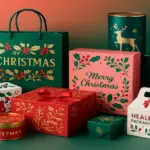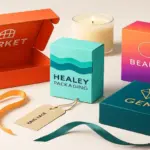In today’s eco-conscious world, sustainable packaging is no longer optional — it’s essential. Brands face growing pressure to lower their environmental impact. At the same time, they must meet the expectations of consumers who value sustainability. This blog explores what sustainable packaging really means. It looks at the rise of innovative materials, the challenges facing the industry, and real-world success stories. You’ll find inspiring examples from major brands like Lush, Nestlé, and Dell.
Sustainable packaging is designed to leave a minimal impact on the environment. This applies throughout its entire life cycle—from sourcing and production to transport, use, and disposal. It relies on eco-friendly materials, efficient processes, and supports the principles of a circular economy.
Innovative Materials in Sustainable Packaging
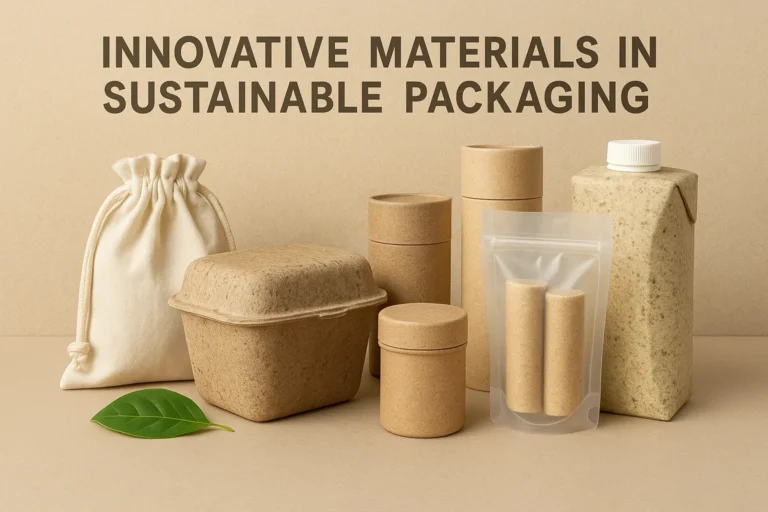
Biodegradable and Compostable Packaging
Biodegradable and compostable materials are leading the charge in green sustainable packaging. Common materials include plant-based plastics, cornstarch, and biodegradable paper fibres. These break down naturally over time, helping to reduce long-term waste. They are ideal for eco-friendly product packaging, especially for brands focused on environmental responsibility.
These materials help reduce pollution and attract today’s conscious consumer. People value transparency and care about sustainability. Brands that use these alternatives stand out as leaders in sustainable product packaging. This builds trust and adds long-term value to the brand.
Recyclable and Upcycled Packaging Materials
Recyclable packaging materials are vital to promoting a circular economy. More brands are now using packaging made from post-consumer recycled materials. This includes cardboard, aluminium, and PET plastic. Upcycled materials—like repurposed fabric or agricultural waste—are also gaining popularity. They offer creative, low-impact alternatives for packaging design.
Using these materials helps reduce landfill waste. It also conserves valuable natural resources. Companies that choose recyclable packaging show their commitment to the environment. This not only supports sustainability but also strengthens their green reputation in the market.
Minimalist and Low-Waste Designs
Minimalist packaging prioritises simplicity and efficiency. Sustainable packaging reduces the use of unnecessary materials and resources. This makes it an ideal choice for small business owners. It not only lowers environmental impact but also reduces costs. Sustainable packing proves that being eco-friendly can also be affordable.
Minimalist design plays a key role in this approach. Using fewer colours and inks, and avoiding non-recyclable fillers, enhances both style and sustainability. It’s a smart choice for brands that want a clean, modern look while following eco-friendly principles.
Challenges in Implementing Sustainable Packaging
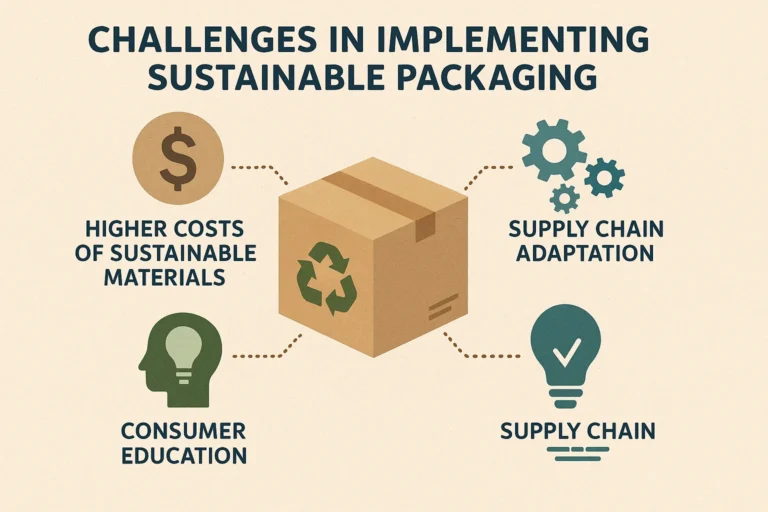
Higher Costs of Sustainable Materials
One of the biggest hurdles brands face is the upfront cost of switching to eco packaging materials. While traditional plastic is cheap, using eco-friendly materials in product packaging often costs more. This is because of higher production costs and the investment needed for innovation.
For smaller brands, this can be particularly challenging. However, the long-term value—such as enhanced brand image, customer retention, and regulatory compliance—often outweighs the initial investment. Moreover, costs continue to decline as demand for sustainable solutions grows.
Supply Chain Adaptation
Implementing custom eco friendly packaging requires reevaluating procurement, manufacturing, and distribution processes. ready to meet the expectations of today’s environmentally conscious consumers. For many companies, switching to materials like bioplastics or compostable fibres can be a challenge. It often means making changes across the entire supply chain.
This may involve finding new suppliers, retraining staff, upgrading equipment, and rethinking how products are delivered. Despite these hurdles, the benefits are clear. Brands that embrace this shift show true leadership in sustainability. They stand out as innovative and future-ready, meeting the expectations of today’s eco-conscious consumers.
Consumer Education
Although demand for eco friendly packaging is growing, some consumers may be hesitant. There’s often a perception that green materials are less durable. Clear labelling, consumer education, and honest storytelling are essential for building trust. They help show that your sustainable packaging is reliable and truly eco-friendly.
Brands should explain the benefits of their packaging. This includes how to dispose of it, what makes it sustainable, and why it matters. When customers understand their role in environmental change, they feel more connected to your brand.
Sustainable Packaging Case Studies
Lush Cosmetics: Packaging-Free Innovation
Lush has become synonymous with sustainability in packaging. Its “naked” range features completely packaging-free products like shampoo bars and bath bombs. Lush is a great example. Where packaging is needed, they use 100% recycled and recyclable materials. They also educate customers with clear, simple messages on their packaging.
Although they faced challenges like maintaining hygiene and shelf life, Lush stayed committed. Their dedication to reducing waste has made packaging a key part of their brand story. It’s a prime example of how brands can innovate successfully while embracing sustainable packaging ideas.
Nestlé: Commitment to Recyclability by 2025
Nestlé is a global leader integrating green packaging across its product lines. Their pledge to make all packaging recyclable or reusable by 2025 has driven the development of paper-based food wraps and dissolvable capsules. Through partnerships with eco friendly packaging companies, Nestlé is transforming the food industry.
Their efforts show how large companies can drive real change in sustainable packaging. By investing in R&D, working closely with suppliers, and improving infrastructure, they make large-scale impact possible.
Dell Technologies: Eco-Friendly Innovation in Electronics
Dell uses mushroom-based and bamboo-based packaging — a standout in biodegradable packaging for electronics. After thorough testing, these materials were shown to be strong enough to protect tech products. They combine custom eco-friendly packaging with both functionality and innovation.
This smart use of natural materials shows what’s possible. It proves that tech companies can align their packaging with sustainability goals. In doing so, they earn greater consumer trust and industry recognition.
Future Trends in Sustainable Packaging
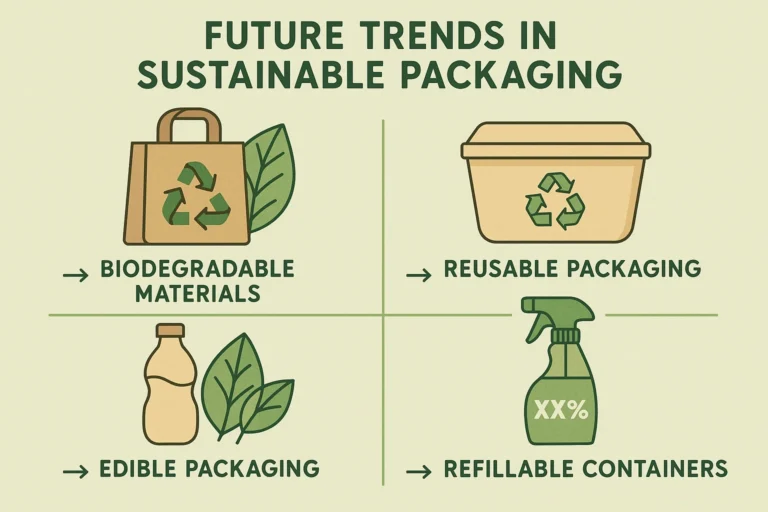
Increased Use of Bioplastics
Bioplastics derived from cornstarch, sugarcane, or seaweed are rapidly gaining traction as sustainable packing materials. As costs decrease, adoption among both large corporations and small brands is expected to rise.
Smart and Connected Packaging
More companies are starting to use smart labels. These labels offer traceability, recycling instructions, and ways to engage customers. They help connect sustainability goals with modern technology.
Collaborative Industry Initiatives
Partnerships are driving real change. Material scientists, manufacturers, and eco-friendly packaging companies are working together. These collaborations are essential for creating sustainable designs at scale and affordable prices.
New innovations are already emerging. From carbon-negative materials to edible wrappers, the future of packaging is changing fast. This next wave of ideas is set to transform how we think about sustainable packaging design.

Conclusion: Packaging the Future Responsibly
Incorporating sustainable packaging solutions isn’t just a trend — it’s a business imperative. As seen in the success stories of Lush, Nestlé, and Dell, innovation drives results. Taking on challenges leads to stronger brand loyalty, a better reputation, and real environmental benefits.
Whether you’re a global company or a small artisan brand, eco-friendly packaging can make a big impact. It helps elevate your product and aligns your business with today’s conscious consumers. Explore packaging ideas that reduce waste. Educate your customers through your packaging choices. Work with experts to create packaging that protects both your product and the planet. By investing in sustainable materials and design, your brand leads the way to a greener future. Using recyclable packaging shows innovation and responsibility. These are traits customers will value and remember.
At Healey Packaging, we’re proud to support the global shift toward sustainability. We offer a wide range of eco-friendly packaging solutions made from recyclable, biodegradable, and compostable materials. Our mission is to help brands reduce waste and lower their environmental impact. We believe you shouldn’t have to sacrifice quality or creativity to go green. Contact us in building a cleaner, greener future—one box at a time.



